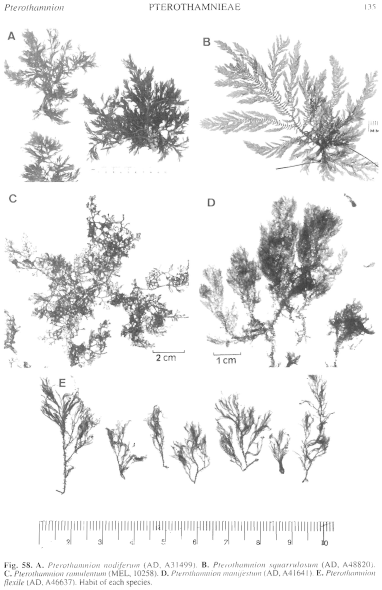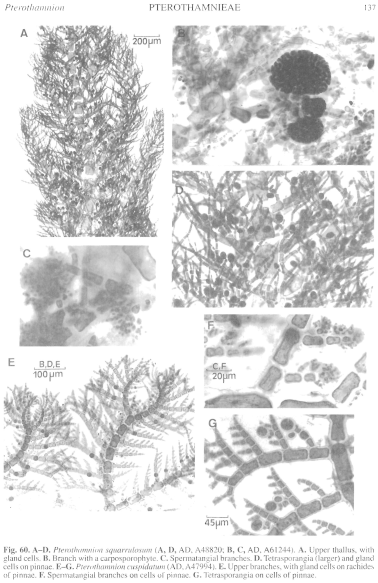|
|
|
|
|
|||||||||||
|
Electronic Flora of South Australia Species Fact Sheet
Phylum Rhodophyta – Order Ceramiales – Family Ceramiaceae – Tribe Pterothamnieae
Selected citations: Athanasiadis 1996: 73.
Synonyms
Wrangelia squarrulosa Harvey 1855c: 236.
Platythamnion squarrulosum (Harvey) Adams 1994: 246, pl. 90, upper right.
Thallus (Fig. 58B) medium to dark red-brown, erect, 5–20 cm high, complanately branched with alternate lateral branches usually 2–5 axial cells apart but also arising adventitiously; upper axes straight to slightly flexuous (Fig. 60A). Axes near the base of larger plants densely corticated by entwined rhizoids arising from the basal cells of whorl-branchlets. Holdfast rhizoidal, 1–2 mm across, epilithic or usually epiphytic on larger algae. Structure. Apical cells 6–8 µm in diameter and L/D 1.5–2, enlarging in the lower axis to 250–400 µm in diameter and L/D 1.5–2; basal cortical rhizoids 15–25 µm in diameter, cells L/D 5–8. Axial cells each with 4 whorl-branchlets, of similar development but the 2 minor ones slightly shorter (150–300 µm long) than the major ones (350–550 µm long) which lie in the plane of the thallus. Whorl-branchlets (Fig. 60A, D) adaxially branched but becoming subdichotomous; basal cells (30–) 45–90 µm in diameter and L/D 1.5–2, tapering to subterminal cells 8–12 µm in diameter and L/D 1–1.5, with mucronate terminal cells; gland cells (Fig. 60A) profuse, often in series on cells of whorl-branchlets or on the corticating rhizoids, ovoid, oblique, 10–25 µm in diameter. Lateral branches arising from axial cells or by further growth of whorl-branchlets. Cells uninucleate; rhodoplasts discoid to elongate in small cells, in chains or ribbon like in larger cells.
Reproduction: Gametophytes dioecious. Carpogonial branches are borne on the basal (supporting) cells of whorl-branchlets, singly or up to 3 on successive branchlets. Post-fertilization the auxiliary cell divides to form a foot cell and upper gonimoblast initial which cuts off 2–7 successive globular gonimolobes (Fig. 60B) 150–225 µm across of angular carposporangia 10–15 µm across; cells basal to the carposporophyte form a fusion cell, and lower whorl-branchlets laxly surround the carposporophyte. Spermatangial clusters (Fig. 60C) occur on cells of the pinnules, with ovoid spermatangia 2–2.5 µm in diameter.
Tetrasporangia (Fig. 60D) occur laterally or terminally on special branches on the whorl-branchlets, ovoid, 20–30 µm in diameter, cruciately or decussately divided.
Type from Preservation Harbour, South I., New Zealand (Lyall, Jan. 1851); lectotype in Herb. Hooker, BM.
Selected specimens: 1.3 km off Cape Northumberland, S. Aust., 15 m deep (Shepherd, 26.x.1977: AD, A48820). Warrnambool, Vic., drift (Kraft & Herrington, 6.xi.1989; MEL, 39989, AD, A66647 and A61244).
Distribution: Southern New Zealand.
In southern Australia, known from Cape Northumberland, S. Aust., and Warrnambool, Victoria.
References:
ADAMS, N.M. (1994). Seaweeds of New Zealand. (Cant. Univ. Press: Christchurch.)
ATHANASIADIS, A. & KRAFT, G.T. (1994). Description of Pterothamnion squarrulosum (Harvey) comb. nov. from south-eastern Australia and southern New Zealand, with a taxonomic re-assessment of the genera Pterothamnion, Platythamnion & Glandothamnus (Ceramiaceae, Rhodophyta). Eur. J. Phycol. 29, 119–133.
ATHANASIADIS, A. (1996). Morphology and classification of the Ceramioideae (Rhodophyta) based on phylogenetic principles. Opera Botanica No. 128, pp. 1–216.
HARVEY, W.H. (1855c). Algae. In Hooker, J.D., The Botany of the Antarctic Voyage. II. Flora Novae-Zelandiae. Part II, pp. 211–266, Plates 107–121. (Reeve: London.)
The Marine Benthic Flora of Southern Australia Part IIIC complete list of references.
Publication:
Womersley, H.B.S. (24 December, 1998)
The Marine Benthic Flora of Southern Australia
Rhodophyta. Part IIIC. Ceramiales – Ceramiaceae, Dasyaceae
©State Herbarium of South Australia, Government of South Australia
Illustrations in Womersley Part IIIA, 1998: FIGS 58B, 60 A–D.

Figure 58 enlarge
Fig. 58. A. Pterothamnion nodiferum (AD, A31499). B. Pterothamnion squarrulosum (AD, A48820). C. Pterothamnion ramulentum (MEL, 10258). D. Pterothamnion manifestum (AD, A41641). E. Pterothamnion flexile (AD, A46637). Habit of each species.

Figure 60 enlarge
Fig. 60. A–D. Pterothamnion squarrulosum (A, D, AD, A48820; B, C, AD, A61244). A. Upper thallus, with gland cells. B. Branch with a carposporophyte. C. Spermatangial branches. D. Tetrasporangia (larger) and gland cells on pinnae. E–G.Pterothamnion cuspidatum (AD, A47994). E. Upper branches, with gland cells on rachides of pinnae. F. Spermatangial branches on cells of pinnae. G. Tetrasporangia on cells of pinnae.

|
Email Contact: State Herbarium of South Australia |

|